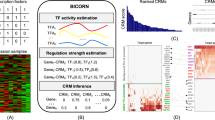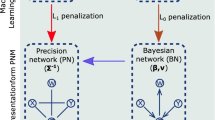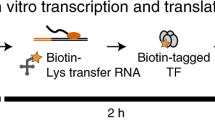Abstract
The identification of co-regulated genes and their transcription-factor binding sites (TFBS) are key steps toward understanding transcription regulation. In addition to effective laboratory assays, various computational approaches for the detection of TFBS in promoter regions of coexpressed genes have been developed. The availability of complete genome sequences combined with the likelihood that transcription factors and their cognate sites are often conserved during evolution has led to the development of phylogenetic footprinting1,2. The modus operandi of this technique is to search for conserved motifs upstream of orthologous genes from closely related species1,2. The method can identify hundreds of TFBS without prior knowledge of co-regulation or coexpression. Because many of these predicted sites are likely to be bound by the same transcription factor, motifs with similar patterns can be put into clusters so as to infer the sets of co-regulated genes, that is, the regulons. This strategy utilizes only genome sequence information and is complementary to and confirmative of gene expression data generated by microarray experiments. However, the limited data available to characterize individual binding patterns, the variation in motif alignment, motif width, and base conservation, and the lack of knowledge of the number and sizes of regulons make this inference problem difficult. We have developed a Gibbs sampling-based3 Bayesian motif clustering (BMC) algorithm to address these challenges. Tests on simulated data sets show that BMC produces many fewer errors than hierarchical and K-means clustering methods4. The application of BMC to hundreds of predicted γ-proteobacterial motifs2 correctly identified many experimentally reported regulons, inferred the existence of previously unreported members of these regulons, and suggested novel regulons.
This is a preview of subscription content, access via your institution
Access options
Subscribe to this journal
Receive 12 print issues and online access
$209.00 per year
only $17.42 per issue
Buy this article
- Purchase on Springer Link
- Instant access to full article PDF
Prices may be subject to local taxes which are calculated during checkout



Similar content being viewed by others
References
McCue, L.A. et al. Phylogenetic footprinting of transcription factor binding sites in proteobacterial genomes. Nucleic Acids Res. 29, 774–782 (2001).
McCue, L.A., Thompson, W., Carmack, C.S. & Lawrence, C.E. Factors influencing the identification of transcription factor binding sites by cross-species comparison. Genome Res. 12, 1523–1532 (2002).
Liu, J.S. Monte Carlo Strategies in Scientific Computing (Springer, New York, 2001).
Everitt, B.S., Landau, S. & Leese, M. Cluster Analysis, edn. 4 (Arnold, London, 2001).
Pietrokovski, S. Searching databases of conserved sequence regions by aligning protein multiple-alignments. Nucleic Acids Res. 24, 3836–3845 (1996).
Hughes, J.D., Estep, P.W., Tarazoie, S. & Church, G.M. Computational identification of cis-regulatory elements associated with groups of functionally related genes in Saccharomyces cerevisiae. J. Mol. Biol. 296, 1205–1214 (2000).
van Nimwegen, E., Zavolan, M., Rajewsky, N. & Siggia, E.D. Probabilistic clustering of sequences: inferring new bacterial regulons by comparative genomics. Proc. Nat. Acad. Sci. USA. 99, 7323–7328 (2002).
Robison, K., McGuire, A.M. & Church, G.M. A comprehensive library of DNA-binding site matrices for 55 proteins applied to the complete Escherichia coli K-12 genome. J. Mol. Biol. 284, 241–254 (1998).
Courcelle, J., Khodursky, A., Peter, B., Brown, P.O. & Hanawalt, P.C. Comparative gene expression profiles following UV exposure in wild-type and SOS-deficient Escherichia coli. Genetics 158, 41–64 (2001).
Hantke, K. Iron and metal regulation in bacteria. Curr. Opin. Microbiol. 4, 172–177 (2001).
Vassinova, N. & Kozyrev, D. A method for direct cloning of Fur-regulated genes: identification of seven new Fur-regulated loci in Escherichia coli. Microbiology 146, 3171–3182 (2000).
Escolar, L., Perez-Martin, J. & de Lorenzo, V. Opening the iron box: transcriptional metalloregulation by the Fur protein. J. Bacteriology 181, 6223–6229 (1999).
Jordan, A. & Reichard, P. Ribonucleotide reductases. Annu. Rev. Biochem. 67, 71–98 (1998).
Han, J.S., Kwon, H.S., Yim, J.-B. & Hwang, D.S. Effect of IciA protein on the expression of the nrd gene encoding ribonucleoside diphosphate reductase in E. coli. Mol. Gen. Genet. 259, 610–614 (1998).
van den Berg, E.A., Geerse, R.H., Memelink, J., Bovenberg, R.A., Magnee, F.A. & van der Putte, P. Analysis of regulatory sequences upstream of the E. coli uvrB gene; involvement of the DnaA protein. Nucleic Acids Res. 13, 1829–1840 (1985).
Neidhardt, F.C. Escherichia coli and Salmonella: Cellular and Molecular Biology (ASM Press, Washington, DC, 1996).
Liu, J.S., Neuwald, A.F. & Lawrence, C.E. Bayesian models for multiple local sequence alignment and Gibbs sampling strategies. J. Amer. Stat. Assoc. 90, 1156–1170 (1995).
Azam, T.A. & Ishihama, A. Twelve species of the nucleoid-associated protein from Escherichia coli. Sequence recognition specificity and DNA binding affinity. J. Biol. Chem. 274, 33105–33113 (1999).
Jeon, Y., Lee, Y.S., Han, J.S., Kim, J.B. & Hwang, D.S. Multimerization of phosphorylated and non-phosphorylated ArcA is necessary for the response regulator function of the Arc two-component signal transduction system. J. Biol. Chem. 276, 40873–40879 (2001).
Schneider, T.D. & Stephens, R.M. Sequence logos: a new way to display consensus sequences. Nucleic Acids Res. 18, 6097–6100 (1990).
Acknowledgements
This research was partly supported by US National Institutes of Health (NIH) grant R01HG02518-01 and National Science Foundation grants DMS-0104129 and DMS-0204674 to J.S.L., NIH grant R01HG01257 to C.E.L., and Department of Energy grant DEFG0201ER63204 to C.E.L. and L.A.M.
Author information
Authors and Affiliations
Corresponding author
Ethics declarations
Competing interests
The authors declare no competing financial interests.
Rights and permissions
About this article
Cite this article
Qin, Z., McCue, L., Thompson, W. et al. Identification of co-regulated genes through Bayesian clustering of predicted regulatory binding sites. Nat Biotechnol 21, 435–439 (2003). https://doi.org/10.1038/nbt802
Received:
Accepted:
Published:
Issue Date:
DOI: https://doi.org/10.1038/nbt802
This article is cited by
-
Phylogenetic footprinting: a boost for microbial regulatory genomics
Protoplasma (2012)
-
Simultaneous prediction of transcription factor binding sites in a group of prokaryotic genomes
BMC Bioinformatics (2010)
-
Extensive horizontal transfer of core genome genes between two Lactobacillus species found in the gastrointestinal tract
BMC Evolutionary Biology (2007)
-
More robust detection of motifs in coexpressed genes by using phylogenetic information
BMC Bioinformatics (2006)



